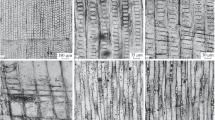Abstract
An Unusual Xylotheque with Plant Illustrations from Early Meiji Japan. Two unusual wood collections, reported previously in the collections of the Botanical Museum at Berlin-Dahlem and the Royal Botanic Gardens, Kew, take the form of framed plant illustrations painted on boards made from the wood of the species illustrated. We present new finds of very similar wood collections in the Economic Botany Collection of the Harvard University Herbaria, a private collection in the U.K. (Loudon collection), and at the Koishikawa Botanical Garden of the University of Tokyo. A stamp on the reverse of the boards links all five collections to Chikusai Kato, an artist working at Tokyo University (now the University of Tokyo) in early Meiji Japan, under the direction of the preeminent nineteenth century Japanese botanist Keisuke Ito. New evidence from contemporary historical accounts indicates that more than 100 boards were ordered in June 1878 by Hiroyuki Katō, the first president of Tokyo University, most likely to support the early teaching of Western-influenced botanical science in Japan. However, while the boards had clear value for teaching, especially about useful plants, their unusual fusion of Western and Japanese influences also made them desirable craft objects that were collected and given as gifts during the early Meiji era.
明治初期に日本で作られた特異な植物図版について
これまでベルリン・ダーレムの植物博物館とイギリス王立キュー植物園に知られていた植物図版は、枠付きの木製の板の上に描かれており、その板はその植物の材を用いられていることで大変特徴的である。最近、同様な植物図版がハーバート大学植物標本館、ロンドン個人コレクション(Loudon氏蔵)と東京大学附属小石川植物園にも見出された。裏面の篆刻印から、これらの植物図版は東京大学創立初期の1878年に当時の著名な植物学者伊藤圭介教授の指導の下に、そこで働いていた植物画家加藤竹斎によって描かれ、制作されたことが分かる。当時の資料などから新たに分かったことは、当初作成された100枚余の植物図版は初代東京大学総長(当時は総理といった)によって、近代的植物科学の教育手段として購入されたと推定される。しかしながら、これら図版は有用植物の教育手段として優れているが、同時に西洋と日本の画法の融合したユニークな図版であることから工芸品としてもみなされ、明治初期には収集されたり、また、贈答品としても用いられていたことが分かった。





Similar content being viewed by others
Literature Cited
Baas, P. 1981. On some wood collections of historical interest. IAWA Bulletin (N.S.) 2(1):45–47.
——— 1982. Systematic, phylogenetic, and ecological wood anatomy: History and perspectives. Pages 23–58 in P. Baas, ed., New perspectives in wood anatomy. Nijhoff/Dr W. Junk Publishers, The Hague.
Baldini, E. 1993a. Documenti di museologia naturalistica: Xiloteche e modelli botanico-pomologici. Museologia Scientifica 9:181–223.
——— 1993b. Documenti de museografia naturalistica: Le xiloteche di Milano e di San Vito di Cadore. Accademia delle Scienze dell’ Istituto di Bologna, Classe di Scienze Fisische, Bologna.
Bellermann, J. B. 1788. Abbildungen zum Cabinet der vorzüglichsten in- und ausländischen Holzarten. F. Bellermann, Erfurt.
Desmond, R. 2007. The history of the Royal Botanic Gardens, Kew. Royal Botanic Gardens, Kew.
Feuchter-Schawelka, A., W. Freitag, and D. Grosser. 2001. Alte Holzsammlungen: Die Ebersberger Holzbibliothek: Vorgänger, Vorbilder und Nachfolger. Geschichte und Gegenwart, Ebersberg.
Ito, K. 2010. Kinkaou-Nisshi (Diary of Keisuke Ito) vol. 16. April–June 1878. Study Group of Keisuke Literatures, Nagoya.
Ito, T. 1900. A short memoir of Ito Keisuké, Rigaku Hakushi. Annals of Botany 14(3):401–411.
Kawahara, K. 1837. Somoku Kajitsu Shashin Zufu (A collection of pictures of plants and fruits). 4 vols. Maekawa Zembei, Osaka.
Kimura, Y. and V. I. Grubov. 1993. Siebold’s florilegium of Japanese plants. Maruzen, Tokyo.
Kraml, P. A. 1992. Die Xylothek der Sternwarte Kremsmünster. Naturwissenschaftliche Sammlungen Kremsmünster. Berichte des Anselm Desing Vereins 25:1–15.
Lack, H. W. 1999. Plant illustration on wood blocks: A magnificent Japanese xylotheque of the early Meiji period. Curtis’s Botanical Magazine 16(2):124–134.
——— and H. Ohba. 1998. Die Xylothek des Chikusai Kato. Willdenowia 28:263–275.
Morse, E. S. 1917. Japan day by day. Vol. 1. Houghton Mifflin Company, Boston and New York.
Nagata, T. 2011. Presents from the 11th year of Meiji. Newsletter of the Friend’s Society of the Koishikawa Botanical Garden 41:3–8 (In Japanese).
Nesbitt, M. 2010. Puzzling panels. Kew Magazine Spring 2010:54–55.
Praprotnik, N. 1990. Zbirka vzorcev lesa v Priroslovnem muzeju Slovenije. Proteus 53:124–126.
Sato, D. 2011. Modern Japanese art and the Meiji state: The politics of beauty. Getty Publications, Los Angeles.
Siebold, P. F. v. and J. G. Zuccarini. 1835–1870. Flora Japonica, sive, Plantae in Imperio Japonica collegit, descripsit, ex parte in ipsis locis pingendas. Lugduni Batavorum, apud auctorem.
Speta, F. 1992. Eine brasilianische Xylothek vom Kaiser Brasiliens. Linzer Biologische Beiträge 24(1):367–373.
Stern, W. L. 1988. Index Xylariorum. Institutional wood collections of the world. 3. IAWA Bulletin (N.S.) 9:203–252.
van Gulik, W. R. 1986. In het spoor van de Liefde: Japans–Nederlandse ontmoetingen sins 1600. De Bataafsche Leeuw, Amsterdam.
Weston, V. L. 2003. Institutionalizing talent and the Kano legacy at the Tokyo School of Fine Arts, 1889–1893. Pages 147–177 in B. G. Jordon and V. L. Weston, eds., Copying the artist and stealing his secrets: Talent and training in Japanese painting. University of Hawai’i Press, Honolulu.
Wiśniewski, J. 2000. Księgi drzewne. Rocznik Dendrologiczny 48:7–24. Wood books.
——— 2001. “Księgi drzewne” w muzeach Warszawy i Kazimierza Dolnego. Rocznik Dendrologiczny 49:175–181. Wood books at Warsaw and Kazimierz Dolny museums.
Yamaguchi, T. and N. Kato. 1998. Mogami Tokunai’s collection of wood specimens donated to von Siebold and now housed in the Rijksherbarium, Leiden. Calanus Special Number II. Aitsu Marine Biological Station, Kumamoto.
Acknowledgments
We thank Judith Warnement and Lisa DeCesare for their assistance with the Harvard collections, and Kathrin Grotz and Sarah Bollendorff for kindly facilitating access to and photography of the collections in the Botanical Museum Berlin-Dahlem. We also thank Mio Kitayama for help with Japanese translations, and we are deeply indebted to Professor Jin Murata, Director of the Koishikawa Botanical Garden, for access to the Koishikawa collection and for permission to publish an image of the Chikusai Kato illustration of Ginkgo biloba. We thank Dr. Tetsuo Ohi-Toma for providing the images of the Koishikawa boards. This paper benefited enormously from constructive comments by two anonymous reviewers.
Author information
Authors and Affiliations
Corresponding author
Electronic supplementary material
Below is the link to the electronic supplementary material.
ESM 1
(DOCX 57.7 kb)
Rights and permissions
About this article
Cite this article
Nagata, T., DuVal, A., Lack, H.W. et al. An Unusual Xylotheque with Plant Illustrations from Early Meiji Japan. Econ Bot 67, 87–97 (2013). https://doi.org/10.1007/s12231-013-9227-6
Received:
Accepted:
Published:
Issue Date:
DOI: https://doi.org/10.1007/s12231-013-9227-6




